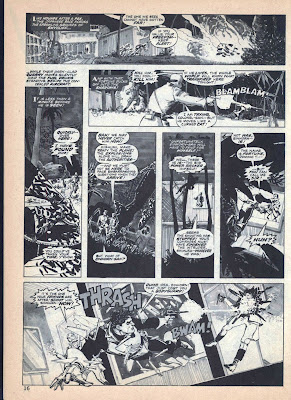by Ernie Colon
DC Graphic Novel No. 3, 1984
'The Medusa Chain' (48 pp) was written and illustrated by veteran American comic artist Ernie Colon (b. 1931), and published by DC Comics as 'Graphic Novel' No. 3 in 1984.
As the novel opens main character Chon ('John') Adams, experienced pilot, is being sentenced - for the crime of conspiracy and murder - to serve six years aboard the deep space cargo transport assembly (or 'chain'), the Medusa.
The Medusa is crewed by the scum of the galaxy, including a healthy leavening of homicidal mutants who don't take kindly to the presence of Adams aboard their ship.
The Medusa's captain, Commander Kilg-9, is herself a mutant, but is too preoccupied with the covert nature of her ship's mission to spend much time disciplining the crew.
Chon Adams is no weakling, however. He's quite able to take care of himself....even when confronted with multiple opponents......
As the voyage of the Medusa progresses, Chon Adams makes a disturbing discovery ......the ship's true mission is not a simple cargo run, but something far more sinister and risky. And it doesn't help that Top Drill Sergeant Basenga and his goons want to see Adams subjected to a special kind of mutilation.......
As conditions aboard the Medusa turn from vile to suicidal, it's up to Chon Adams to come up with the sort of desperate plan that got him convicted of conspiracy and murder in the first place....but this time, the fate of the Federation itself is at stake.....
Colon's artwork for 'The Medusa Chain' is not his strongest; it has a rushed, sketchy quality.........saved to some extent by vigorous, often gory, action sequences.
But Colon's plot is what makes 'Medusa' stand out.
Chon Adams is not your usual hero; rather, he's more of an antihero in the mold of Cody Starbuck. I won't disclose any spoilers, but I will say that Adams is happy to shift his moral stance when circumstances require that he do so. And while he is willing and able to employ violence to achieve his aims, at the same time, he adheres to his own peculiar, but steadfast, code of ethics.
"The Medusa Chain' is one of the better of the first series of DC Graphic Novels. Copies can be had for reasonable prices (i.e., under $8.00) from your usual online vendors; it's worth picking up.












































































